319th Operations Group
The 319th Operations Group is a United States Air Force unit assigned to 319th Reconnaissance Wing Air Combat Command. It is stationed at Grand Forks Air Force Base, North Dakota operating RQ-4 Global Hawk remotely piloted aircraft (RPA) in the intelligence, surveillance and reconnaissance (ISR) role.
| 319th Operations Group | |
|---|---|
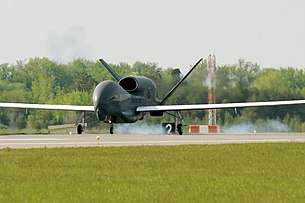 RQ-4 Global Hawk landing at Grand Forks AFB | |
| Active | 1942–1945; 1946–1949; 1949–1951; 1955–1957; 1991–2010 |
| Country | |
| Branch | |
| Role | air refueling |
| Engagements | Mediterranean Theater of Operations Pacific Ocean Theater[1] |
| Decorations | Distinguished Unit Citation French Croix de Guerre with Palm[1] |
| Insignia | |
| 319th Operations Group emblem[note 1] |  |
| Postwar 319th Bombardment Group emblem[note 2] | 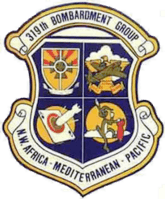 |
The group was first activated during World War II as the 319th Bombardment Group, the first Martin B-26 Marauder group in the Mediterranean Theater of Operations (MTO) during the war. The group received two Distinguished Unit Citations during the war. In 1945, the group was re-equipped with the North American B-25 Mitchell in combat in the MTO before returning to the US to transition to the Douglas A-26 Invader. After retraining the group deployed to Okinawa, where it flew combat missions over China as part of Seventh Air Force against Imperial Japanese forces until the war's end. One of the original Mercury Seven astronauts, Deke Slayton, flew A-26s from Okinawa as a part of the group's 438th Bombardment Squadron in 1945.
The group was reactivated in the reserve in December 1946. It does not appear to have been fully manned or equipped, and when mobilized in 1951 for the Korean War, its personnel were used to man other units and the group was inactivated. It again became part of the reserve force in 1955 as the 319th Fighter-Bomber Group, but was inactivated in 1957, when the reserves converted to the troop carrier mission. It remained inactive until 1991.
In 2019 the group was reactivated at Grand Forks Air Force Base as the Operations Group in charge of all active duty RQ-4 Global Hawk operations.
History
World War II
![]()

The 319th Bombardment Group trained in Louisiana in Martin B-26 Marauders and after completing initial training, the group reported in October and November 1942 to England for staging to the Mediterranean Theater of Operations, where it was assigned to the Twelfth Air Force.[2]
After it moved to Algeria as the first Marauder unit in that theater, arriving with just 15 aircraft and losing group commander Col. Alvord Rutherford over France en route, the 319th entered combat for the first time on 28 November, bombing and strafing warehouses, docks, and railroad yards at Sfax in Tunisia. From then to March 1943, the group bombed German and Italian targets in Tunisia and Libya, including airfields and enemy shipping along the Mediterranean Coast. The 319th trained in French Morocco from March, then returned to combat in June 1943, attacking enemy targets on Italian islands in the Mediterranean, including Sicily, Sardinia, and Pantelleria. From bases in Algeria and Tunisia, the group supported the Allied invasion of Italy, bombing bridges and marshalling yards during the late summer and early autumn of 1943. In November, it moved to Sardinia, to strike Axis targets in central Italy. Early in 1944, the 319th supported Allied ground forces as they advanced in the Cassino and Anzio areas. Later in the year, using North American B-25 Mitchell bombers the group attacked German supply lines in northern Italy, bombing bridges, marshalling yards, and roads. In March, it earned two Distinguished Unit Citations for raids on marshalling yards in Rome and Florence that damaged enemy communications without destroying cultural monuments. For supporting the Allied ground advance in Italy during April, May, and June 1944, the group earned the French Croix de Guerre with Palm. During the summer, it bombed bridges over the Po River in northern Italy using B-25 bombers to block the stream of German supplies and reinforcements going southward. The 319th Bombardment Group supported the invasion of southern France in August 1944 by attacking coastal batteries, radar stations, and bridges. From Corsica, it hit railroad bridges in Northern Italy and late in the year attacked railroad lines through the Brenner Pass that connected Germany and Austria with Italy.[2]
In January 1945, the 319th returned to the United States, where it began to train with Douglas A-26 Invader aircraft for operations in the Pacific Ocean Theater. Between May and July 1945, the group moved by ship to Okinawa, and on 16 July flew its first mission against Japan. From then until the end of the fighting in early August, the 319th attacked enemy targets such as airfields and industrial centers on Kyūshū and occupied Shanghai area of China, and shipping around the Ryukyu Islands and in the East China Sea. In November and December 1945, the group returned to the United States.[2]
Air Force reserve
Initial activation and mobilization for the Korean War
The group was activated again in the reserve under Air Defense Command (ADC) at Mitchel Field, New York in December 1946, although as a headquarters only, with no squadrons assigned.[1] Its four World War II squadrons had all been allotted to the National Guard,[3][4][5][6] and it was not until April 1947 that it was assigned squadrons, the 46th Bombardment Squadron, a newly-constituted unit,[note 3] and the 50th Bombardment Squadron, which had been disbanded during the war.[7] The group was filled out in July 1947, when two more disbanded squadrons, the 51st and 59th Bombardment Squadrons, were reconstituted and assigned to the group.[8][9]
At Mitchel, the group trained under the supervision of the 113th AAF Base Unit (later the 2230 Air Force Reserve Training Center), although it is not clear whether any of its elements were fully manned or equipped during this period. In July 1948 Continental Air Command (ConAC) assumed responsibility for managing reserve and Air National Guard units from ADC.[10] The 319th's stay at Mitchel ended when ConAC reorganized its reserve units under the wing base organization system in June 1949.[1] President Truman's reduced 1949 defense budget also required reductions in the number of groups in the Air Force to 49.[11] and group was replaced as the reserve flying unit at Mitchel by the 84th Fighter Group, a corollary reserve unit integrated with the active duty 52d Fighter Wing.[1][12][13][14]
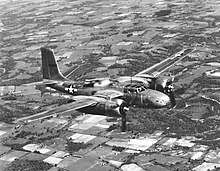
The group moved on paper to Reading Municipal Airport, Pennsylvania, where it replaced the 322d Bombardment Group.[15] Under the new organizational model, it became part of the 319th Bombardment Wing.[16] At Reading the group trained under the supervision of the 2237th Air Force Reserve Training Center. Although the group was assigned four squadrons rather than the three of active duty units, they were manned at 25% of normal strength.[17] Runway length at Reading, however, led ConAC to decide to station a troop carrier unit there, and the group was inactivated on 2 October 1949 and its equipment and personnel were transferred to the 512th Troop Carrier Group.[1][18]
The group activated again about a month later, on 10 October 1949 at Birmingham Municipal Airport, Alabama, where it replaced the 514th Troop Carrier Group. Training at Birmingham was conducted by the 2587th Air Force Reserve Training Center. All reserve combat and corollary units were mobilized for the Korean war,[19] and the 319th was called up on 10 March 1951. Its personnel and aircraft were used as fillers for other units,[20] and the group was inactivated on 22 March.[1]
Fighter operations
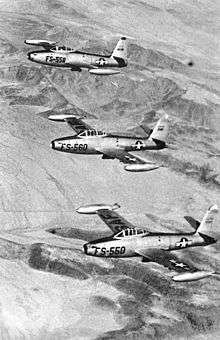
The reserve mobilization for the Korean War had left the reserve without aircraft, and reserve units did not receive aircraft until July 1952.[21] The Air Force desired that all reserve units be designed to augment the regular forces in the event of a national emergency. The six reserve pilot training wings, including the 8710th Pilot Training Wing at Memphis Municipal Airport, Tennessee, had no mobilization mission. On 18 May 1955, the 8710th was discontinued and replaced by the 319th Fighter-Bomber Wing.[22] The group, redesignated the 319th Fighter-Bomber Group, was activated as the wing's flying headquarters, with the 46th Fighter-Bomber Squadron as its only component.[1] The group flew Republic F-84 Thunderjets until 1957, when it began to receive North American F-86 Sabres.[16] Despite its designation as a fighter bomber group, its mission initially was in the air defense role and it was gained by ADC upon mobilization.[23][24] Later the group assumed a tactical fighter role.[23] In 1957, the 50th Fighter-Bomber Squadron was added to the group, although it was located at New Orleans Naval Air Station, under what was termed the Detached Squadron Concept.[7][25]
Meanwhile, the Joint Chiefs of Staff were pressuring the Air Force to provide more wartime airlift. At the same time, about 150 Fairchild C-119 Flying Boxcars became available from the active force. Consequently, in November 1956 the Air Force directed ConAC to convert three reserve fighter bomber wings to the troop carrier mission by September 1957. In addition, within the Air Staff was a recommendation that the reserve fighter mission given to the Air National Guard and replaced by the troop carrier mission.[26] Cuts in the budget in 1957 also led to a reduction in the number of reserve wings from 24 to 15.[27] The 319th Fighter-Bomber Wing and its support elements were inactivated on 16 November 1957 in this reduction of reserve wings. Although the 319th Group was also inactivated that day, its place was taken by the 445th Troop Carrier Group.[1][16][28]
Reactivation at Grand Forks
Bomber operations
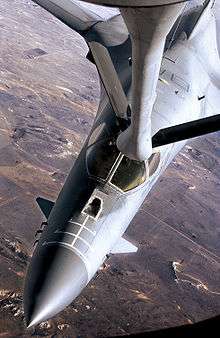
The group was reactivated at Grand Forks Air Force Base, North Dakota in on 1 September 1991 as the 319th Operations Group when Strategic Air Command (SAC) implemented the Objective Wing organization for its units. The group was assigned to the 319th Wing and was assigned the 46th Bomb Squadron, flying the Rockwell B-1B Lancer, the 905th Air Refueling Squadron, flying the Boeing KC-135 Stratotanker and the 319th Operations Support Squadron. Shortly after the group was activated, President George H.W. Bush directed on 28 September that the group no longer keep half of its aircraft on nuclear alert and the group began to focus on training for conventional bombing missions. This became the group's primary mission in February 1993.[29]
In July 1992, the Air Force reorganized its combat commands. SAC's The bomber mission and the 319th Wing were assigned to Air Combat Command (ACC), while the air refueling mission was assigned to Air Mobility Command (AMC). In this reorganization, the 905th Air Refueling Squadron was reassigned from the group, although it remained at Grand Forks. In late February and March 1992, the group set a dozen world time-to-climb records to various altitudes with its Lancer aircraft.[30] However, the transfer of the air refueling mission required a major realignment of the tanker force and by 1994, the Air Force decided that Grand Forks was to become one of three "super tanker" bases. On 1 October 1993, the 319th transferred from ACC to AMC. It regained the 905th Air Refueling Squadron, but the 46th Bomb Squadron was transferred to the 319th Bomb Group.[31][note 4]
Air refueling operations
In 1994, the 319th gained the 906th, 911th and 912th Air Refueling Squadrons equipped with KC-135R and KC-135T aircraft.[32][33][34] In its first active years, he group deployed aircrews and aircraft to support Operation Provide Comfort, humanitarian relief to Kurds fleeing Iraq to in Turkey; Operation Southern Watch, enforcing the no fly zone in southern Iraq; Operation Vigilant Warrior, the deployment of forces to Saudi Arabia to counter threats from Iraq; Operation Deny Flight, enforcing the no-fly zone in Bosnia Herzegovina; Operation Uphold Democracy, the removal of a military junta in Haiti; and Operation Constant Vigil, counter-drug operations based in Panama.[31]
Toward the end of 1998 and into 1999, the group deployed resources to the Persian Gulf and Europe in support of Operation Desert Fox, attacks on Iraqi WMD sites for failing to comply with United Nations mandates; and Operation Allied Force, operations in Kosovo against Serbia. During the summer of 2000, the group operated from MacDill Air Force Base, Florida as major repairs were made to the runways at Grand Forks. From MacDill, the 319th continued to deploy for Operations Northern and Southern Watch and also Operation Joint Forge in Bosnia Herzegovina, operating from Istres-Le Tubé Air Base, France. Following the 9/11 attacks, the group stood up a quick reaction alert force to support homeland defense in Operation Noble Eagle, and deployed resources for Operation Enduring Freedom.[35]
The group's deployments included deployments in which it was the primary force provider for expeditionary operations. In those cases, a 319th Air Expeditionary Group was activated as a provisional unit, deployed to a makeshift tent city somewhere in the arid desert of Southwest Asia. From the start of air operations over Afghanistan 7 October, by 2 November 2001 the 319th Air Expeditionary Group ad flown over 150 sorties and more than 1050 hours; pumping over 1.4 million US gallons (5,300 m3) of gas into more than 450 planes. The expeditionary group includes not only operational, but maintenance organizations. Its deployment location was not officially identified, but is likely to have been Masirah Air Base, where the RAF and USAF have long had facilities.
The group began to diminish in size in June 2007, when the 911th Air Refueling Squadron inactivated.[33] The 906th Squadron followed on 2 October 2009,[32] and the 912th on 1 October 2010.[34] The group's first refueling squadron, the 905th, was the last operational squadron of the group. The wing frequently deployed elements to Southwest Asia, occasionally being the major force provider for the 319th Air Expeditionary Group. They both inactivated on 31 December 2010, as manned flying operations ended at Grand Forks.[36][37]
Lineage
- Established as the 319th Bombardment Group (Medium) on 19 June 1942
- Activated on 26 June 1942
- Redesignated 319th Bombardment Group, Medium on 20 August 1943
- Redesignated 319th Bombardment Group, Light on 3 February 1945
- Inactivated on 18 December 1945
- Activated in the reserve on 27 December 1946
- Inactivated on 2 September 1949
- Activated in the Reserve on 10 October 1949
- Ordered to active duty on 10 March 1951
- Inactivated on 22 March 1951
- Redesignated 319th Fighter-Bomber Group on 12 April 1955
- Activated in the reserve on 18 May 1955[38]
- Inactivated on 16 November 1957
- Redesignated 319th Bombardment Group, Heavy on 31 July 1985 (remained inactive)
- Redesignated 319th Operations Group on 29 August 1991
- Activated on 1 September 1991
- Inactivated on 31 December 2010[37]
Assignments
|
|
Components
- 46th Bombardment Squadron (later 46th Fighter-Bomber Squadron, 46th Bomb Squadron): 16 April 1947 – 2 September 1949; 10 October 1949 – 22 March 1951; 18 May 1955 – 16 November 1957; 1 September 1991 – 1 October 1993
- 50th Bombardment Squadron (later 50th Fighter-Bomber Squadron): 16 April 1947 – 2 September 1949; 10 October 1949 – 22 March 1951; 8 June–18 November 1957[7]
- New Orleans Naval Air Station, Louisiana, 1957
- 51st Bombardment Squadron: 8 July 1947 – 2 September 1949; 10 October 1949 – 22 March 1951[8]
- 59th Bombardment Squadron: 8 July 1947 – 2 September 1949; 10 October 1949 – 22 March 1951[9]
- 437th Bombardment Squadron: 26 June 1942 – 18 December 1945[3]
- 438th Bombardment Squadron: 26 June 1942 – 13 December 1945[4]
- 439th Bombardment Squadron: 26 June 1942 – 18 December 1945[5]
- 440th Bombardment Squadron: 26 June 1942 – 18 December 1945[6]
- 905th Air Refueling Squadron: 1 September 1991 – 1 June 1992; 1 October 1993 – 31 December 2010[36]
- 906th Air Refueling Squadron: 30 January 1994 – 2 October 2009[32]
- 911th Air Refueling Squadron: 29 April 1994 – 30 June 2007[33]
- 912th Air Refueling Squadron: 1 April 1994 – 1 October 2010[34]
Stations
|
|
Aircraft
- Martin B-26 Marauder, 1942–1944[1]
- North American B-25 Mitchell, 1944[1]
- Douglas A-26 Invader, 1945,[1] by 1949–1951[16]
- North American T-6 Texan, by 1949–1951[16]
- Beechcraft T-7 Navigator, by 1949–1951[16]
- Beechcraft T-11 Kansan, by 1949–1951[16]
- Lockheed T-33 T-Bird, 1955–1957[16]
- Republic F-84 Thunderjet, 1955–1957[16]
- North American F-86 Sabre, 1955–1957[16]
- Rockwell B-1B Lancer, 1991–1993
- Beechcraft C-12 Huron 1991–1995
- Boeing KC-135 Stratotanker, 1991–1992, 1993–2010
See also
- List of Martin B-26 Marauder operators
- 514th Air Service Group World War II support organization for the group
References
Notes
- Explanatory notes
- When assigned to the 319th Wing, the group uses the wing emblem with the group designation on the scroll. Air Force Instruction 84–105, Organizational Lineage, Honors and Heraldry, 19 March 2013, para 3.3.3.
- This emblem was used during the war in a slightly different form. Ths shield was straight-sided and there were no scrolls. Watkins, pp. 82–83.
- The World War II 46th Bombardment Squadron had become the 22d Antisubmarine Squadron and was then disbanded. Maurer, Combat Squadrons, pp. 114–115.
- The 319th Bomb Group was a new organization, and not related to the 319th Operations Group, despite the similarity of its name to 319th Bombardment Group.
- Citations
- Maurer, Combat Units, pp. 198–199
- "319th Bombardment Group". Retrieved 27 March 2020.
- Maurer, Combat Squadrons, p. 541
- Maurer, Combat Squadrons, p. 542
- Maurer, Combat Squadrons, pp. 543–544
- Maurer, Combat Squadrons, pp. 544–545
- Maurer, Combat Squadrons, p. 215
- Maurer, Combat Squadrons, p. 217
- Maurer, Combat Squadrons, pp. 232–233
- "Abstract, Mission Project Closeup, Continental Air Command". Air Force History Index. 27 December 1961. Retrieved 24 March 2014.
- Knaack, p. 25
- Cantwell, p. 73
- Maurer, Combat Units, pp. 150–151
- Ravenstein, pp. 85–86
- Maurer, Combat Units, pp. 202–203
- Ravenstein, pp. 168–169
- Cantwell, p. 74
- Maurer, Combat Units, pp. 20–21
- Cantwell, p. 87
- Cantwell, pp. 96, 137
- Cantwell, p. 139
- Cantwell, p. 146
- 'Cantwell, p. 152
- Cantwell, p. 148
- Cantwell, pp. 156, 169
- Cantwell, p. 168
- Cantwell, pp. 168–169
- Haulman, Daniel L. (28 December 2007). "445 Operations Group (AFRC)". Air Force Historical Research Agency. Retrieved 16 August 2013.
- History of Grand Forks, pp. 9–10
- History of Grand Forks, p.14
- History of Grand Forks, p.10
- Robertson, Patsy (6 April 2012). "Factsheet 906 Air Refueling Squadron (AMC)". Air Force Historical Research Agency. Archived from the original on 5 March 2014. Retrieved 24 February 2014.
- Robertson, Patsy (13 May 2008). "Factsheet 911 Air Refueling Squadron (AMC)". Air Force Historical Research Agency. Retrieved 9 January 2018.
- Robertson, Patsy (26 April 2011). "Factsheet 912 Air Refueling Squadron (AMC)". Air Force Historical Research Agency. Archived from the original on 13 April 2014. Retrieved 9 April 2014.
- History of Grand Forks, p.11
- No byline (31 March 2008). "Factsheet 905 Air Refueling Squadron (AMC)". Air Force Historical Research Agency. Archived from the original on 2 March 2014. Retrieved 23 February 2014.
- Research Division, Air Force Historical Research Agency, Air Force Organization Change Status Report, December 2010, Maxwell AFB, AL
- Lineage through 1957 in Maurer, Combat Units, pp. 198–199.
- "Factsheet 47 Air Division". Air Force Historical Research Agency. 5 October 2007. Archived from the original on 17 October 2012. Retrieved 4 April 2014.
- "Factsheet 42 Air Division". Air Force Historical Research Agency. 5 October 2007. Archived from the original on 20 October 2012. Retrieved 4 April 2014.
- "Factsheet 57 Air Division". Air Force Historical Research Agency. 5 October 2007. Archived from the original on 13 October 2012. Retrieved 2 April 2014.
- "Factsheet 4 Air Division". Air Force Historical Research Agency. Archived from the original on 30 October 2012. Retrieved 12 March 2014.
- Station number in Anderson.
Bibliography
![]()
- Anderson, Capt. Barry (1985). Army Air Forces Stations: A Guide to the Stations Where U.S. Army Air Forces Personnel Served in the United Kingdom During World War II (PDF). Maxwell AFB, AL: Research Division, USAF Historical Research Center. Archived from the original (PDF) on 23 January 2016. Retrieved 28 June 2017.
- Cantwell, Gerald T. (1997). Citizen Airmen: a History of the Air Force Reserve, 1946–1994. Washington, D.C.: Air Force History and Museums Program. ISBN 0-16049-269-6. Retrieved 17 December 2016.
- Johnson, 1st Lt. David C. (1988). U.S. Army Air Forces Continental Airfields (ETO) D-Day to V-E Day (PDF). Maxwell AFB, AL: Research Division, USAF Historical Research Center. Archived from the original (PDF) on 29 September 2015. Retrieved 26 June 2017.
- Knaack, Marcelle Size (1978). Encyclopedia of US Air Force Aircraft and Missile Systems (PDF). Vol. 2, Post-World War II Bombers 1945–1973. Washington, DC: Office of Air Force History. ISBN 0-912799-59-5. Retrieved 17 December 2016.
- Maurer, Maurer, ed. (1983) [1961]. Air Force Combat Units of World War II (PDF) (reprint ed.). Washington, DC: Office of Air Force History. ISBN 0-912799-02-1. LCCN 61060979.
- Maurer, Maurer, ed. (1982) [1969]. Combat Squadrons of the Air Force, World War II (PDF) (reprint ed.). Washington, DC: Office of Air Force History. ISBN 0-405-12194-6. LCCN 70605402. OCLC 72556. Retrieved 17 December 2016.
- Ravenstein, Charles A. (1984). Air Force Combat Wings, Lineage & Honors Histories 1947–1977. Washington, DC: Office of Air Force History. ISBN 0-912799-12-9.
- Anonymous (2007). History of Grand Forks Air Force Base and the 319th Air Refueling Wing (PDF). Grand Forks AFB, SD: Wing Command Section, 319th Air Refueling Wing. Archived from the original (PDF) on 28 December 2013.
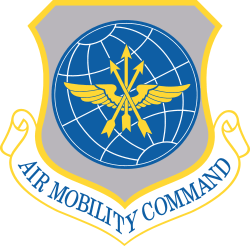

.svg.png)
.svg.png)